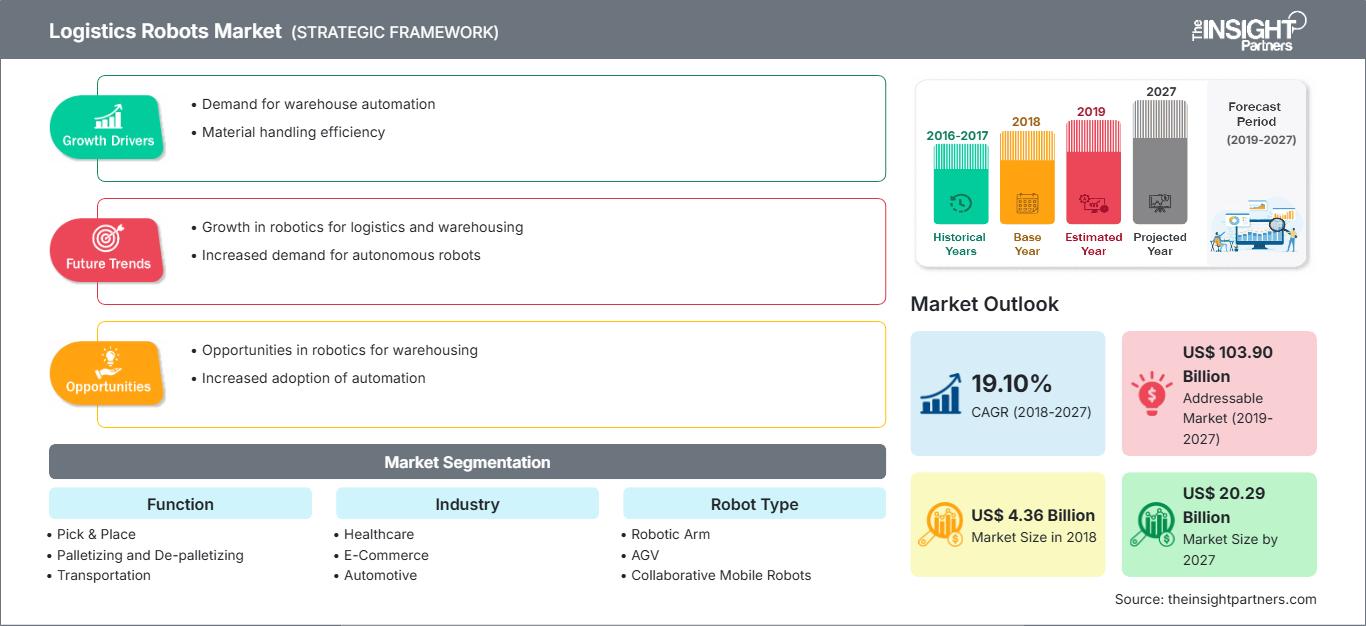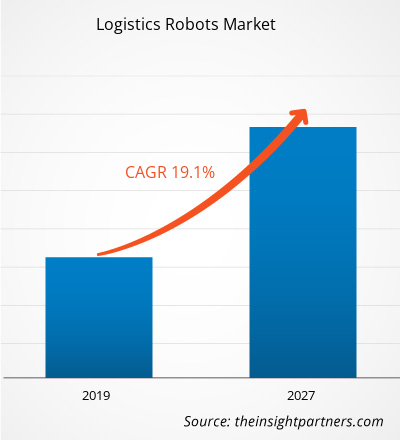물류 로봇 시장은 2018년 43억 5,620만 달러 규모였으며, 2019년부터 2027년까지 연평균 성장률 19.10%로 성장하여 2027년에는 202억 9,340만 달러에 이를 것으로 예상됩니다.
시장 경쟁력을 유지하기 위해 효율성, 속도 향상, 수익 증대라는 이점을 얻기 위해 로봇 도입에 적극적으로 주력하는 물류 및 창고 기업의 수가 증가하고 있습니다. 저렴한 가격으로 운영 효율성을 높이기 위해 로봇 창고 및 물류 기술과 같은 첨단 기술 도입이 증가하고 있습니다. 글로벌 물류 로봇 시장은 전 세계적으로 인구 고령화로 인한 노동력 부족 및 공급망 네트워크의 확대와 같은 요인에 의해 주도되고 있지만, 물류 로봇 도입을 위한 높은 자본 투자는 예측 기간 동안 물류 로봇 시장의 성장을 저해할 것으로 예상됩니다. 그러나 아시아 태평양 및 유럽 국가의 창고 자동화 증가와 확고한 시장 기반은 가까운 미래에 업계 참여자들의 시장 점유율을 향상시킬 수 있는 상당한 성장 기회를 제공할 것으로 예상됩니다.
시장 분석: 전 세계적으로 고령화 인구 증가로 인한 노동력 부족
전 세계적으로 고령화 인구 비율이 증가하는 것은 다양한 산업의 노동력 감축을 초래하는 주요 요인 중 하나입니다. 전 세계 각국은 지역 사회의 고령 인구가 급증하는 현상을 목격하고 있습니다. 인구 고령화는 노동 시장뿐만 아니라 금융 시장까지 모든 분야에서 21세기 사회 변화를 이끄는 주요 요인 중 하나가 되었습니다. 이탈리아, 일본 등 여러 국가는 65세 이상 인구의 상당 부분을 차지하는 고령화 인구 비율이 가장 높은 국가입니다. 세계보건기구(WHO)에 따르면 2050년까지 전 세계 60세 이상 인구는 약 200만 명으로, 2000년의 세 배에 달할 것으로 예상됩니다. 고령화 인구의 급증은 노동력 부족의 원인입니다. 여러 산업 분야에서 물류 로봇 도입은 전반적인 프로세스 비용 절감, 생산성 향상, 안전성 강화, 인적 오류 감소라는 측면에서 중요한 역할을 합니다. 전 세계 창고의 급속한 기술 발전은 공급망 프로세스가 직면한 어려움과 관련된 요구 사항과 비즈니스 목표 달성에 필요한 기술을 확보하는 데 중점을 두고 있습니다. 제품 수명 주기의 다양한 단위, 기능 및 단계에 걸쳐 로봇을 도입하는 것은 오늘날 창고 산업이 성장하는 데 있어 핵심 과제였으며, 이는 가까운 미래에 물류 로봇 시장을 활성화할 것입니다.
이 보고서의 일부, 국가 수준 분석, Excel 데이터 팩을 포함하여 모든 보고서에 대한 사용자 정의를 무료로 받을 수 있을 뿐만 아니라 스타트업 및 대학을 위한 훌륭한 제안 및 할인을 이용할 수 있습니다
물류 로봇 시장: 전략적 통찰력

- 이 보고서의 주요 주요 시장 동향을 확인하세요.이 무료 샘플에는 시장 동향부터 추정 및 예측에 이르기까지 데이터 분석이 포함됩니다.
협동 모바일 로봇 부문은 글로벌 물류 로봇 시장에서 가장 큰 점유율을 차지했습니다. 포장, 기계 관리, 자재 취급 등 다양한 작업을 수행하기 위해 다양한 산업 분야에 도입되고 있으며, 이러한 협동 로봇은 중장비 작업부터 경량 작업까지 모두 처리할 수 있을 만큼 능숙합니다. 협동 로봇은 정확도, 유연성, 정밀성이 매우 높습니다. 또한, 유지보수가 용이하고 재구성 및 재프로그래밍이 용이합니다. 이러한 로봇은 민감한 작업도 처리할 수 있으며, 제조 공정 중 발생하는 불일치에 따라 스스로 조정합니다. 협동 로봇은 온보드 분석 및 보고서를 제공하기 위한 중요한 지표를 수집하여 의사 결정 프로세스를 간소화하고 전체 물류 로봇 시장을 주도합니다.
기능 통찰력
운송 부문은 글로벌 물류 로봇 시장에서 가장 큰 점유율을 차지했습니다. 상품이 팔레트에 적재되고, 여러 제품의 형태와 크기가 미세하게 다르기 때문에 이러한 상품의 적재 및 하역을 자동화해야 했습니다. 3D 레이저 비전은 새로운 로봇 소프트웨어와 통합되어 사용자가 컨테이너에 있는 다양한 제품을 확인하고, 이상적인 적재/하역 순서를 결정하며, 높은 정확도로 프로세스를 수행할 수 있도록 지원합니다. 물류 로봇은 목표 랙 이동, 바스켓 인출 및 들어올리기, 선반에서 포크 펼침, 목표 위치 복귀 등에 사용되며, 이는 전체 물류 로봇 시장을 주도합니다.
산업 분석
아웃소싱 물류 부문은 글로벌 물류 로봇 시장에서 가장 큰 점유율을 차지했습니다. 이러한 물류 서비스 제공업체는 창고, 재고 관리, 운송, 유통, 주문 이행, 화물 혼재 등 다양한 서비스를 제공합니다. 적시 배송 관리 및 운송 비용 절감에 대한 수요 증가, 재고 자재 기록 관리 강화, 핵심 사업 및 기업 자산 감소는 예측 기간 동안 물류 로봇 시장을 견인할 것으로 예상됩니다.
기업들은 전 세계적으로 사업 영역을 확장하고 증가하는 수요를 충족하기 위해 여러 가지 시장 주도 전략을 채택하고 있습니다. 이러한 전략은 주로 유럽과 아시아 태평양 지역에서 관찰됩니다. 물류 로봇 시장 참여 기업들은 전 세계 고객 기반을 확대하기 위해 확장 및 연구 개발 투자 전략을 채택하고 있으며, 이를 통해 전 세계적으로 브랜드 인지도를 유지할 수 있습니다.
물류 로봇 시장 지역별 통찰력
The Insight Partners의 분석가들은 예측 기간 동안 물류 로봇 시장에 영향을 미치는 지역별 동향과 요인을 면밀히 분석했습니다. 이 섹션에서는 북미, 유럽, 아시아 태평양, 중동 및 아프리카, 그리고 중남미 지역의 물류 로봇 시장 부문 및 지역별 현황도 다룹니다.
물류 로봇 시장 보고서 범위
| 보고서 속성 | 세부 |
|---|---|
| 시장 규모 2018 | US$ 4.36 Billion |
| 시장규모별 2027 | US$ 20.29 Billion |
| 글로벌 CAGR (2018 - 2027) | 19.10% |
| 이전 데이터 | 2016-2017 |
| 예측 기간 | 2019-2027 |
| 다루는 세그먼트 |
By 기능
|
| 포함된 지역 및 국가 | 북미
|
| 시장 선도 기업 및 주요 회사 프로필 |
|
물류 로봇 시장 참여자 밀도: 비즈니스 역학에 미치는 영향 이해
물류 로봇 시장은 소비자 선호도 변화, 기술 발전, 그리고 제품의 이점에 대한 인식 제고 등의 요인으로 인한 최종 사용자 수요 증가에 힘입어 빠르게 성장하고 있습니다. 수요가 증가함에 따라 기업들은 제품 및 서비스를 확장하고, 소비자 니즈를 충족하기 위한 혁신을 추진하며, 새로운 트렌드를 적극 활용하고 있으며, 이는 시장 성장을 더욱 가속화하고 있습니다.

- 을 얻으세요 물류 로봇 시장 주요 주요 플레이어 개요
- 로봇 팔
- AGV
- 협동 모바일 로봇
- 기타
물류 로봇 시장 - 기능별
- 픽앤플레이스
- 팔레타이징 및 디팔레타이징
- 운송
- 포장
물류 로봇 시장 - 산업별
- 헬스케어
- 전자상거래
- 자동차
- 아웃소싱 물류
- 소매
- 소비재
- 식품 및 음료
- 기타
물류 로봇 시장 - 지리별
북미
- 미국
- 캐나다
- 멕시코
유럽
- 프랑스
- 독일
- 이탈리아
- 영국
- 러시아
- 유럽의 나머지 지역
아시아 태평양
- 중국
- 인도
- 한국
- 일본
- 호주
- 아시아 태평양의 나머지 지역
중동 및 아프리카
- 남아프리카공화국
- 사우디아라비아
- UAE
- 중동 및 아프리카 기타 지역
남아메리카
- 브라질
- 아르헨티나
- 남아메리카 기타 지역
회사 프로필
- AGV International
- Clearpath Robotics
- Daifuku Co. Ltd.
- Fanuc Corporation
- Fetch Robotics Inc.
- Kion Group AG
- KNAPP AG
- Kollmorgen
- KUKA AG
- Toshiba Corporation
- 과거 분석(2년), 기준 연도, CAGR을 포함한 예측(7년)
- PEST 및 SWOT 분석
- 시장 규모 가치/거래량 - 글로벌, 지역, 국가
- 산업 및 경쟁 환경
- Excel 데이터세트
최근 보고서
관련 보고서
사용 후기
구매 이유
- 정보에 기반한 의사 결정
- 시장 역학 이해
- 경쟁 분석
- 고객 인사이트
- 시장 예측
- 위험 완화
- 전략 기획
- 투자 타당성 분석
- 신흥 시장 파악
- 마케팅 전략 강화
- 운영 효율성 향상
- 규제 동향에 발맞춰 대응




















 무료 샘플 받기 - 물류 로봇 시장
무료 샘플 받기 - 물류 로봇 시장